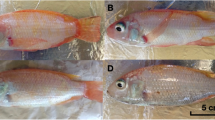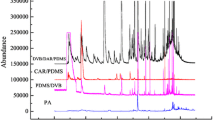Abstract
Sea cucumber, Apostichopus japonicus (Selenka), is a commercially important marine species in China. Among the differently colored varieties sold in China, white and purple sea cucumbers have the greatest appeal to consumers. Identification of the pigments that may contribute to the formation of different color morphs of sea cucumbers will provide a scientific basis for improving the cultivability of desirable color morphs. In this study, sea cucumbers were divided into four categories according to their body color: white, light green, dark green, and purple. The pigment composition and contents in the four groups were analyzed by high performance liquid chromatography (HPLC). The results show that the pigment contents differed significantly among the white, lightgreen, dark-green, and purple sea cucumbers, and there were fewer types of pigments in white sea cucumber than in the other color morphs. The only pigments detected in white sea cucumbers were guanine and pteroic acid. Guanine and pteroic acid are structural colors, and they were also detected in light-green, dark-green, and purple sea cucumbers. Every pigment detected, except for pteroic acid, was present at a higher concentration in purple morphs than in the other color morphs. The biological color pigments melanin, astaxanthin, β-carotene, and lutein were detected in light-green, dark-green, and purple sea cucumbers. While progesterone and lycopene, which are also biological color pigments, were not detected in any of the color morphs. Melanin was the major pigment contributing to body color, and its concentration increased with deepening color of the sea cucumber body. Transmission electron microscopy analyses revealed that white sea cucumbers had the fewest epidermal melanocytes in the body wall, and their melanocytes contained fewer melanosomes as well as non-pigmented pre-melanosomes. Sea cucumbers with deeper body colors contained more melanin granules. In the body wall of dark-green and purple sea cucumbers, melanin granules were secreted out of the cell. The results of this study provide evidence for the main factors responsible for differences in coloration among white, light-green, darkgreen, and purple sea cucumbers, and also provide the foundation for further research on the formation of body color in sea cucumber, A. japonicus.
Similar content being viewed by others

References
Bai Yucen, Zhang Libin, Liu Shilin, et al. 2015. The effect of salinity on the growth, energy budget and physiological performance of green, white and purple color morphs of sea cucumber, Apostichopus japonicus. Aquaculture, 437: 297–303
Chen Jiaxin. 2003. Overview of sea cucumber farming and sea ranching practices in China. SPC Beche-de-mer Inf Bull, 18: 18–23
Choe S, Ohshima Y. 1961. On the morphological and ecological differences between two commercial forms, "Green" and "Red", of the Japanese common sea cucumber, Stichopus japonicus Selenka. Nipp Suis Gakka, 27: 97–105
Guerin M, Huntley M E, Olaizola M. 2003. Haematococcus astaxanthin: applications for human health and nutrition. Trends Biotechnol, 21(5): 210–216
Hurbain I, Geerts W J C, Boudier T, et al. 2008. Electron tomography of early melanosomes: implications for melanogenesis and the generation of fibrillar amyloid sheets. Proc Natl Acad Sci U S A, 105(50): 19726–19731
Jiang Senhao, Dong Shuanglin, Gao Qinfeng, et al. 2013. Comparative study on nutrient composition and growth of green and red sea cucumber, Apostichopus japonicus (Selenka, 1867), under the same culture conditions. Aquac Res, 44(2): 317–320
Kanno M, Kijima A. 2002. High genetic variability of isozymes in Japanese sea cucumber Stichopus japonicus. Fish Genet Breed Sci, 3: 7–12
Kan-No M, Kijima A. 2003. Genetic differentiation among three color variants of Japanese sea cucumber Stichopus japonicus. Fish Sci, 69(4): 806–812
Kanno M, Li Qi, Kijima A. 2005. Isolation and characterization of twenty microsatellite loci in Japanese sea cucumber (Stichopus japonicus). Mar Biotechnol, 7(3): 179–183
Kanno M, Suyama Y, Li Qi, et al. 2006. Microsatellite analysis of Japanese sea cucumber, Stichopus (Apostichopus) japonicus, supports reproductive isolation in color variants. Mar Biotechnol, 8(6): 672–685
King R A, Hearing V J, Creel D J, et al. 2001. Albinism. In: Scriver C R, Beaudet A L, Sly W S, et al., eds. The Metabolic and Molecular Bases of Inherited Disease. New York: McGraw-Hill, 4353–4392
Levy-Lior A, Shimoni E, Schwartz O, et al. 2010. Guanine-based biogenic photonic-crystal arrays in fish and spiders. Adv Funct Mater, 20(2): 320–329
Liu Xiaodong, Chen Zaizhong. 2008. Pigment cells and body color regulation of fish. Fish Sci Technol Inf (in Chinese), 35(1): 13–18
Lu Yanjie, Yao Huiyuan. 2003. Advances in physiological functions of lutein and zeaxanthin. Food Ferment Ind (in Chinese), 29(2): 81–85
Nielsen K P, Zhao Lu, Stamnes J J, et al. 2006. The importance of the depth distribution of melanin in skin for DNA protection and other photobiological processes. J Photochem Photobiol B Biol, 82(3): 194–198
Nishimura S. 1995. Guide to Seashore Animals of Japan with Color Pictures and Keys (in Japanese). Osaka: Hoikusha, 310–373
Parker A R. 2000. 515 million years of structural colour. J Opt A Pure Appl Opt, 2(6): R15–R28
Prota G, Thomson R H. 1976. Melanin pigmentation in mammals. Endeavour, 35(224): 32–38
Raposo G, Marks M S. 2007. Melanosomes—dark organelles enlighten endosomal membrane transport. Nat Rev Mol Cell Biol, 8(10): 786–797
Rozanowska M, Sarna T, Land E J, et al. 1999. Free radical scavenging properties of melanin: interaction of eu-and pheo-melanin models with reducing and oxidising radicals. Free Rad Biol Med, 26(5-6): 518–525
Sang C. 1990. Biology of the Japanese common sea cucumber Stichopus japonicus Selenka (in Japanese) [dissertation]. Pusan: Pusan National University
Sarna T, Burke J M, Korytowski W, et al. 2003. Loss of melanin from human RPE with aging: possible role of melanin photooxidation. Exp Eye Res, 76(1): 89–98
Sarna T, Menon I A, Sealy R C. 1985. Photosensitization of melanins: a comparative study. Photochem Photobiol, 42(5): 529–532
Scalia M, Geremia E, Corsaro C, et al. 1990. Lipid peroxidation in pigmented and unpigmented liver tissues: protective role of melanin. Pigment Cell Res, 3(2): 115–119
Schiaffino M V. 2010. Signaling pathways in melanosome biogenesis and pathology. Int J Biochem Cell Biol, 42(7): 1094–1104
Seiji M, Fitzpatrick T B, Simpson R T. 1963. Chemical composition and terminology of specialized organelles (melanosomes and melanin granules) in mammalian melanocytes. Nature, 197(4872): 1082–1084
Slominski A, Tobin D J, Shibahara S, et al. 2004. Melanin pigmentation in mammalian skin and its hormonal regulation. Physiol Rev, 84(4): 1155–1228
Streelman J T, Peichel C L, Parichy D M. 2007. Developmental genetics of adaptation in fishes: the case for novelty. Ann Rev Ecol Evol Syst, 38(1): 655–681
Wakamatsu K, Ito S. 2002. Advanced chemical methods in melanin determination. Pigment Cell Res, 15(3): 174–183
Xu Dongxue, Sun Lina, Liu Shilin, et al. 2015. Histological, ultrastructural and heat shock protein 70 (HSP70) responses to heat stress in the sea cucumber Apostichopus japonicus. Fish Shellfish Immunol, 45(2): 321–326
Yu Guoyong. 1996. The mechanism of animal body color change. Bull Biol (in Chinese), 31(11): 22–24
Zariba M, Bober A, Korytowski W, et al. 1995. The effect of a synthetic neuromelanin on yield of free hydroxyl radicals generated in model systems. Biochim Biophys Acta, 1271(2-3): 343–348
Zhang Wei, Cao Zhengfei, Li Yuchun, et al. 2015. Taxonomic status of the three color variants in sea cucumber (Apostichopus japonicus): evidence from mitochondrial phylogenomic analyses. Mitochondrial DNA A, 27(4): 2330–2333
Zhu Xiuling, Che Zhenming, Xu Wei, et al. 2005. The advancement of the physiological Functions and extraction technology of ß-carotene. J Xihua Univ (Nat Sci) (in Chinese), 24(1): 71–76
Acknowledgements
The authors thank all members of the research department of Shandong Oriental Ocean Sci-Tech Co., Ltd. The authors also thank the two anonymous reviewers for their professional revision of the manuscript.
Author information
Authors and Affiliations
Corresponding author
Additional information
Foundation item: The Agricultural Seed Project of Shandong Province.
Rights and permissions
About this article
Cite this article
Xing, L., Sun, L., Liu, S. et al. Comparison of pigment composition and melanin content among white, light-green, dark-green, and purple morphs of sea cucumber, Apostichopus japonicus . Acta Oceanol. Sin. 36, 45–51 (2017). https://doi.org/10.1007/s13131-017-1056-5
Received:
Accepted:
Published:
Issue Date:
DOI: https://doi.org/10.1007/s13131-017-1056-5



